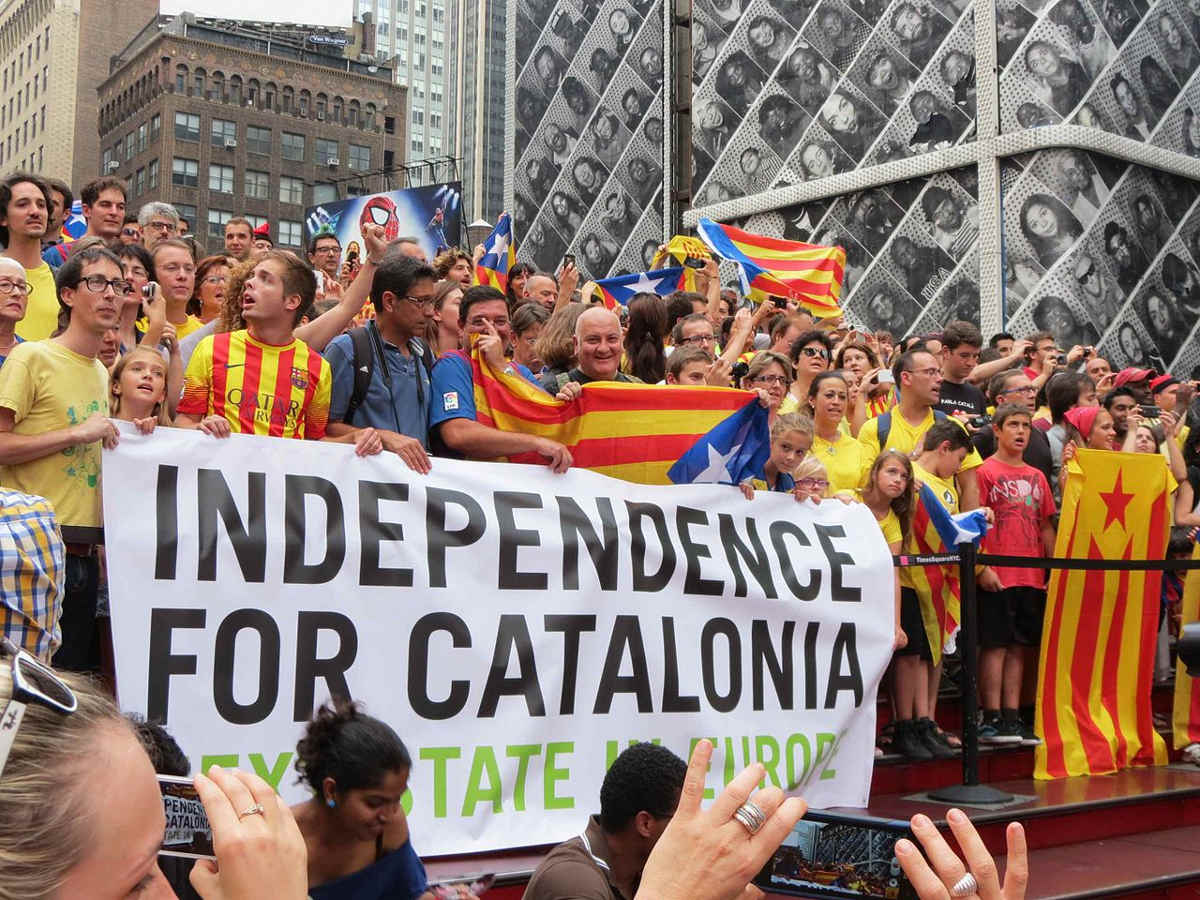LONDON (ViaNews) – “The Catalan crisis poses a threat to the European order” warned the Financial Times on October 6, following the state’s independence referendum a few days before. 3 years ago it was the Scottish vote which cast doubt and worry for many in the continent, with former leader of the Scottish National Party, Jim Sillars, warning what he called ‘scaremongering’ pro-union businesses that a “day of reckoning” was on the way, which would challenge their negative convictions about what separatism would mean for the state.
A pattern of separatist and regionalist demands and votes is underway in Europe. The financial crash a few years ago, a squeezed job market and uneasiness regarding the future are just a few reasons for the reemergence of a stronger set of regional movements on the continent: whilst the Catalan case has hit the headlines in the last weeks and drawn the attention of peoples, governments and businesses across the world, this is just one of the many flourishing separatists or regionalist movements around.
Many stand together, supporting regionalist developments on the other side of Europe, whilst putting together their own agendas, plans, and hopes for more autonomy, for independence.
In Catalonia, of course, the regional parliament recently declared an independence referendum, which was marred by intense violence by the Spanish police, keen to stop the vote they claimed was illegal. Since the resultant declaration of independence, the Spanish government has suspended the regional government and sentenced a number of politicians, including Carles Puigdemont, the leader of the independence movement who called the referendum vote, to long jail terms, for rebellion and sedition.
In Britain, the Scottish independence movement continues to play a significant role north and south of the border.
In Belgium, the Flemish separatist Nieuw-Vlaamse Allliantie (N-VA) is the biggest party in the Belgian parliament, and in 2010-11, over 500 days were needed to form a Belgian government torn over linguistic and cultural differences.
Regions across Italy, particularly in the North, have long had a strong separatist presence, going back to the state’s formation in the latter half of 19th century. Corsica Libera, the separatist political party on the island, which is governed in Paris, also remains strong, campaigning for further devolution.
“We might be located in different corners of Europe, but we’re quite alike”
In 2015, Geert Bourgeois, the founder of the N-VA, declared that both Flanders and Catalonia “are wealthy, […] perform well, with a long cultural tradition, our own language, and our own democracy. We might be located in different corners of Europe, but we’re quite alike”. Bourgeois is also friends with Artur Mas, the ex-leader of the separatist movement in Catalonia and former President there. Quite alike in their clamours for independence, yes, but not so politically. Catalan pride is rooted in left-wing politics; the region was the center of opposition to Franco, who brutally put down both the Catalan language and resistance. The N-VA, however, has a less rigid political position. Once members of the Greens-European Free Alliance in the European Parliament, a group made up of green, regionalist and mainly left-wing political parties, they changed in 2014 to the European Conservatives and Reformist Group, a more conservative and specifically Eurosceptic political collective. Their policies, meanwhile, are generally a pragmatic mix of conservative and liberal ideas. So are they actually all that similar? Would Artur Mas and Geert Bourgeois have actually got on politically, or was it enough to be drawn together by regionalist devotions? However much leaders of these movements declare their affinity to other regionalist movements, things are not as simple as that.
Scotland
So, too, is the reality with the Scottish National Party (SNP). Like the N-VA, they are a populist party, defined by their calls for more autonomy, and perhaps eventual independence, in Scotland, rather than from a particular political standpoint. Although often seen as a progressive party, their political programme allows them to take on policies from different parts of the political spectrum, intended to attract votes from a variety of Scottish citizens. The 2014 referendum campaign, for one, included a commitment to reducing corporation tax, a policy not typically associated with left-wing parties. Far from it. Nicola Sturgeon, the post-referendum party leader, dropped this policy the following year.
At the forefront of their leftwing policies, however, are the free NHS prescriptions and free university places available to all those north of the border.
Some of these political parties defined by a regionalist loyalty, then, have more freedom to declare support for policies from different areas of the political spectrum.
Spain
The Catalan independence movement, however, is sharply defined by its leftwing politics. Franco’s fascist forces, deployed with support from Nazi Germany and Mussolini’s Italy during the Civil War of 1936-1939, found a stronghold in the northwestern tip of Spain. Towards the end of the Civil War, Catalonia and particularly Barcelona remained the last government stronghold against Franco’s forces, fighting until defeat in 1939. The dictatorship which followed saw Franco cracking down on Catalan culture and language, fearful of a regionalist movement which had faced oppression and silencing before, by the Spanish dictator of the 1920s, Miguel Primo de Rivera. During the Franco regime, thousands of Catalans were executed, suspected of harbouring regionalist aspirations. Pride in the opposition to the right-wing dictator remains part of what defines the Catalan independence movement.
Searches for sovereignty brings the various movements together. These demands for self-rule, in turn, are, like the Catalan case, rooted in a history of pride in the locality, of statehood or desired statehood at the expense of the current state. Recent referendums in Northern Italy have, for one, followed a trajectory which was already markedly clear during the fight for Italian independence over the course of the 19th century.
Italy
On 22nd October of this year, Northern Italian states Lombardy and Veneto held referendums over increasing autonomous rule from Rome. Lega Nord, the historically separatist party, called the referendums in states where they lead the governments, hoping for votes for autonomy in regions where the GDP is 30 percent of Italy’s overall Domestic Product. Votes were heavily in favour of increased autonomy, with 98 percent of Venetian voters calling for more powers, and 95 percent of Lombardian votes demanding the same.
The Lega Nord, politically, sits on the opposite side of the spectrum from the Catalan independence movement. Enshrined in conservative leanings, and with a President for Life, Umberto Bossi, the party has in the past demanded separation from the southern states, areas which have focused more on farmland rather than industry. Such economic diversity harks back to the campaigns for Italian unification in the 19th century and beyond.
Go to any Italian town and there will be a Piazza Guiseppe Garibaldi, and most probably, a Piazza Cavour too. Both named after men who were instrumental in the fight for Italian independence in the late 19th century. In Naples, they are just 20 minutes walk from each other, the first the square outside the main station, with a marvelous statue of Guiseppe Garibaldi watching over the people striding up and down the boulevard. The second is tucked off a little more, the statue just a small bust of Camillo di Cavour. The contrast to statues of Cavour in Northern Italy could not be more striking: in the Milanese square, the man stands upon a plinth, infinitely more impressive, gesturing with one hand. Although a proponent of Italian independence, Cavour did not envisage the Italy which exists today. Rather, he fought for a union of the northern Italian states: the south, he argued, was not economically proficient enough to be part of Italy, with one of his agents writing “What lands are these, Molise and the South! What barbarism! […] Compared to these peasants, the Bedouins are the pinnacle of civilization”. No coincidence, then, that Cavour’s statue and square are hidden away in Naples and other southern towns, sometimes with graffiti-strewn over them, whilst, just a few hundred miles north, he is celebrated as one of the principal manufacturers of the Italian state.
Garibaldi’s statue and legacy, however, stands tall throughout Italy, and particularly in the south. It was Garibaldi who twisted Cavour’s plan to, instead, including the southern states in the Italian state. In 1860, with just a thousand followers, he sailed to Sicily, which at the time, was also occupied by the Austrian Empire. Successfully conquering the island in the name of Italian unification, he sailed on to Naples, which he also took. Handing the spoils of war to the Italian king, Victor Emmanuel II, he retired. Cavour, then, had no option but to accept the southern states into Italy. The Expedition of the Thousand is still celebrated as a military stroke of genius, a victory which shaped modern-day Italia. A piece of history, whose ramifications remain contested in Italian politics today.
Belgium
Flemish independence rhetoric is similarly shaped around a contested history between the French-speaking Wallonia and the Dutch-speaking region in the north. Many of these tensions were, similarly, brought to a head in the 19th century, when the Protestant king Willem I of the United Kingdom of Netherlands, which encompassed today’s Belgium as well as the Netherlands and further territories, declared Dutch to be the only official language in law and education. Which, after Belgian independence, swung to the other side with attempts to bring French back as the main language, Dutch was almost ignored in French-speaking schools, and, slowly, it was pushed out of predominance, in the northern Flanders region at least, which historically has close ties to the Netherlands and Dutch-speaking populations. In contrast, southern Wallonia has much stronger links to the French culture and language.
Scotland
So too in Scotland. Declared united with England in 1707, with the Act of Union, history doesn’t look too favourably on the relationship between Scotland and England. The Jacobite rebellions in the northern state, in 1715 and 1745, were both attempts to bring the Scottish Stuart house back to the British throne, which they had ruled when James VI of Scotland became James I of England and Ireland in 1603. The end of their line in 1714, with the death of Queen Anne, saw the end of a Scottish presence on the throne. For centuries, Scottish heroes such as Robert the Bruce, of the 14th century, are remembered for their fights against the English, who meanwhile regarded them as barbarians. Gaelic, a language traditionally spoken in Scotland, is symbolic of the differences in culture and history between England and Scotland, and comparable to the Catalan, spoken now more widely than Gaelic is spoken in Scotland, in the Spanish region.
More recently, referendums have taken place which, although governed by more modern demands for independence, have their origins in the region’s culture and history. The Scottish independence referendum was condoned by the British government in 2014, and, legally binding, it would have seen Scotland break away from the UK to form its own state. The result of this reality was a terrific turnout in the vote, with an average 84.6 percent of Scots casting their opinion. Heralded as a period of extensive political engagement, this harnessed more interest than any other British referendum or election since 1918, when universal suffrage was introduced. Groundbreaking, too, was the decision to allow 16 and 17-year-olds the vote, a move which has sparked off conversations across Britain about extending the franchise. Not only, then, a historic vote, but also a moment of political engagement in a country where, typically, not more than 65 percent of people vote, and considerably less in European elections.
High turnouts here, silent majorities there
Notice a difference to the vote in Barcelona just a few weeks ago? There was no ‘silent majority’, no illegal vote. The Spanish government did not recognize the Catalan referendum, which, fair or unfair, added substantial complications to the mix. Whilst the majority of voters in Catalonia voted for independence, research shows only 42.3% of eligible citizens turned out to vote. Why vote against a policy when the referendum was not legally binding, and, anti-independence voters assumed, it could not lead to policy change?

And this is in a country where, months before the referendum, polls suggested that 41 percent of Catalans supported independence. No wonder the anti-independence Catalans feel hard done by and angry at the declaration of independence. Coupled with intense police brutality, again completely absent from the Scottish example, a resolution to the situation is far from close, with Carles Puigdemont, the leader of the secessionist Catalan European Democratic Party (Partit Demòcrata Europeu Català) and unilateral independence declarant, now arrested by police in Belgium and facing trial for sedition and rebellion back in Spain. A legal referendum would, surely, have allowed for the high turnout and a complete absence of violence.
And of course, this has happened before in the Spanish region. Artur Mas, the party’s ex-leader, was earlier this year barred from political office for two years, for, like Puigdemont, organising an illegal vote, this time in 2014. It seems history may be hanging over not just the Catalan government people, but also Madrid, with continued reference to the post-Franco Spanish constitution, which declared the “indissoluble unity of the Spanish nation”. Perhaps a fear of what there could be to come with a fragmented state.
Italy
In such a light, however, the referendums in Northern Italy could project fears of violence and low turnout. Also arranged by the local governments, and therefore non-binding, they too resulted in high Yes votes, with over 90 percent of Lombardians and Venetians supporting the referendum. The difference, however, is striking. In Veneto, at least, 60 percent of voters went to polling stations, well above the 50.1 percent state quorum. Had there been a quorum in Spain, it begs the question, what would have happened differently?
Just before the votes in Northern Italy, the British Daily Express put out a headline which would have captured so many of their reader’s attention. ‘Italy facing its OWN Catalonia: Referendums in Lombardy and Venice could TOPPLE EU’ the article declared, capital locks and all. Hardly Italy’s “own Catalonia”: rather than independence, the vote had focused on increasing their autonomy from Rome. Whilst perhaps the beginning of a chain reaction, independence referendums will, probably, not swiftly follow. The Lega Nord, built on independence demands from what founder, Umberto Bossi, called regions of southern “lazy corrupt peasants”, has since turned its attention to increasing autonomy, with the new leader, Matteo Salvini, even considering dropping the ‘Nord’ from the name and campaigning in the southern states. In a traditionally ultra-conservative party, the only separatist movement of the ones discussed to have a President for life, Umberto Bossi, Salvini poses a challenge to the original party’s demands. A significant U-turn not seen in Scottish, Catalan or Flemish independence politics of the last decades.
The state of regionalism in Europe
Regionalism’s future in Europe is not clear. Spain is marred by a battle, it seems, she feels she needs to win. Anxiety over the nation’s past and present stability has led to politically motivated violence not seen in Western Europe for decades. In a few weeks, the state goes to regional elections: an attempt by the Spanish government to restore stability to an increasingly fractious state. So too there will be worries that regionalism in Catalonia could spill out into other Spanish regions with a history of regionalism, such as the Basque country. In Scotland, the SNP’s support dropped in the last election, with voters claiming the party were focusing too much attention on the question of independence, and thus, ignoring other issues. If and when Brexit goes through, the Scottish independence question will surely return. Meanwhile, a multitude of Northern Italian states now hope for or already have a level of autonomy, which, some fear, could spiral into calls for independence referendums. With attempts to increase their political position in Italy, however, the Lega Nord might instead further soften their demands, with hopes of building a coalition with another party a high priority.
Perhaps it is Belgium where the next regionalist referendums or votes will take place. In 2016, the N-VA declared that they were preparing an “autonomy strategy” for 2019, which would aim to bring about gradual independence. As the largest party in the Belgian parliament, any declaration of increased autonomy would have a huge impact, not just on Belgium, but also on the rest of Europe.







